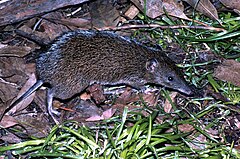Jamraje
| Peramelinae[1] | |||
| J.E. Gray, 1825[2] | |||
 Przedstawiciel rodzaju – krótkonos brązowy (Isoodon obesulus) | |||
| Systematyka | |||
| Domena | |||
|---|---|---|---|
| Królestwo | |||
| Typ | |||
| Podtyp | |||
| Gromada | |||
| Podgromada | |||
| Nadrząd | |||
| Rząd | |||
| Rodzina | |||
| Podrodzina | jamraje | ||
| Typ nomenklatoryczny | |||
Perameles É. Geoffroy Saint-Hilaire, 1804 | |||
| Synonimy | |||
| Rodzaje | |||
| |||
Jamraje[11] (Peramelinae) – podordzina ssaków z rodziny jamrajowatych (Peramelidae).
Zasięg występowania
Podrodzina obejmuje gatunki występujące w Australii[12][13].
Systematyka
Do podrodziny należą następujące rodzaje[12][11]:
- Isoodon Desmarest, 1817 – krótkonos
- Perameles É. Geoffroy Saint-Hilaire, 1804 – jamraj
Przypisy
- ↑ Peramelinae, [w:] Integrated Taxonomic Information System [online] (ang.).
- ↑ a b J.E. Gray. An Outline of an Attempt at the Disposition of Mammalia into Tribes and Families, with a List of the Genera apparently appertaining to each Tribe. „Annals of Philosophy”. New Series. 10, s. 340, 1825. (ang.).
- ↑ G.R. Waterhouse: Mammalia. Marsupialia or Pouched Animals. W: W. Jardine: The Naturalist’s Library. Cz. 24. Edinburgh: W. H. Lizars, 1841, s. 60. (ang.).
- ↑ R.-P. Lesson: Nouveau Tableau du Règne Animal: Mammifères. Paris: Arthus Bertrand, 1842, s. 191. (fr.).
- ↑ P. Gervais: Histoire naturelle des mammifères: avec l’indication de leurs moeurs et de leurs rapports avec les arts, le commerce et l’agriculture. II. Carnivores, proboscidiens, jumentés, bisulques, édentés, marsupiaux, monotrèmes, phoques, sirénides et cétacés. Paris: L. Curmer, 1855, s. 278. (fr.).
- ↑ E. Haeckel: Generelle morphologie der organismen. Allgemeine grundzüge der organischen formen-wissenschaft, mechanisch begründet durch die von Charles Darwin reformirte descendenztheorie. Cz. 2. Berlin: G. Reimer, 1866, s. clvii. (niem.).
- ↑ T.N. Gill. Arrangement of the Families of Mammals; with Analytical Tables. „Smithsonian Miscellaneous collections”. 11, s. 26, 1872. (ang.).
- ↑ B.A. Bensley. On the Evolution of the Australian Marsupialia; with Bemarks on the Relationships of the Marsupials in general. „Transactions of the Linnean Society of London Zoology”. Second series. 9 (3), s. 110, 1903. (ang.).
- ↑ W.K. Gregory & J.K. Mosenthal: Outline classification of the Mammalia recent and extinct. W: H.F. Osborn: The Age of Mammals in Europe, Asia and North America. New York: The Macmillan Company, 1910, s. 516. (ang.).
- ↑ F.S. Szalay: Evolutionary history of the marsupials and an analysis of osteological characters. Cambridge: Cambridge University Press, 1994, s. 42. DOI: 10.1017/CBO9780511565571. ISBN 978-0-511-56557-1. (ang.).
- ↑ a b Nazwy polskie za: W. Cichocki, A. Ważna, J. Cichocki, E. Rajska-Jurgiel, A. Jasiński & W. Bogdanowicz: Polskie nazewnictwo ssaków świata. Warszawa: Muzeum i Instytut Zoologii PAN, 2015, s. 9–10. ISBN 978-83-88147-15-9. (pol. • ang.).
- ↑ a b C.J. Burgin, D.E. Wilson, R.A. Mittermeier, A.B. Rylands, T.E. Lacher & W. Sechrest: Illustrated Checklist of the Mammals of the World. Cz. 1: Monotremata to Rodentia. Barcelona: Lynx Edicions, 2020, s. 72. ISBN 978-84-16728-34-3. (ang.).
- ↑ D.E. Wilson & D.M. Reeder (redaktorzy): Subfamily Peramelinae. [w:] Mammal Species of the World. A Taxonomic and Geographic Reference (Wyd. 3) [on-line]. Johns Hopkins University Press, 2005. [dostęp 2020-10-24].
Media użyte na tej stronie
Autor: (of code) -xfi-, Licencja: CC BY-SA 3.0
The Wikispecies logo created by Zephram Stark based on a concept design by Jeremykemp.
Autor: Bertram Lobert, Licencja: CC BY-SA 3.0
Southern Brown Bandicoot (Isoodon obesulus), female, from Cranbourne, Victoria, Australia.

